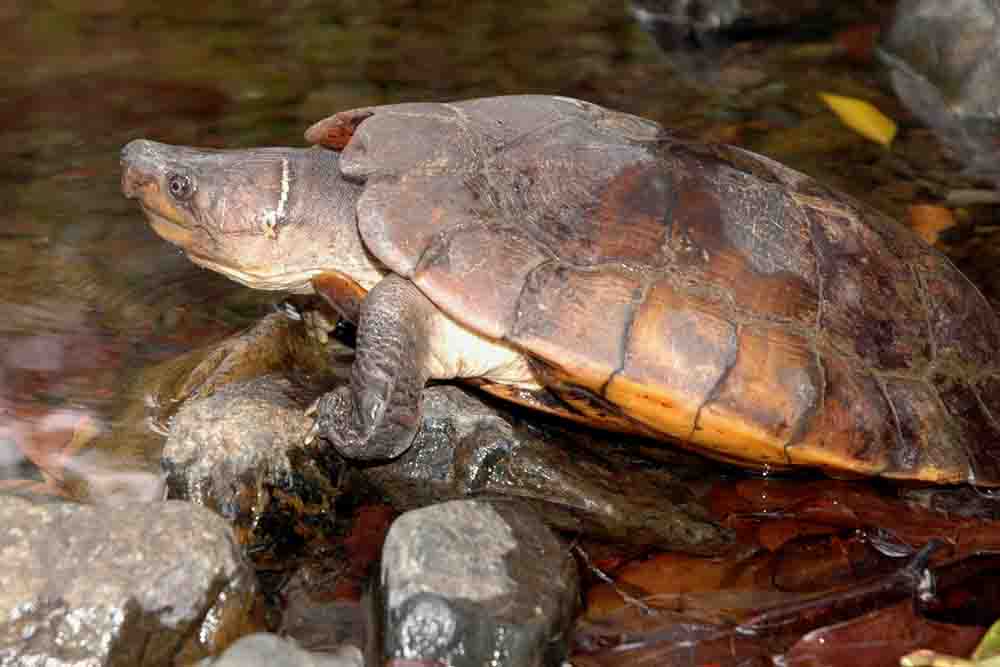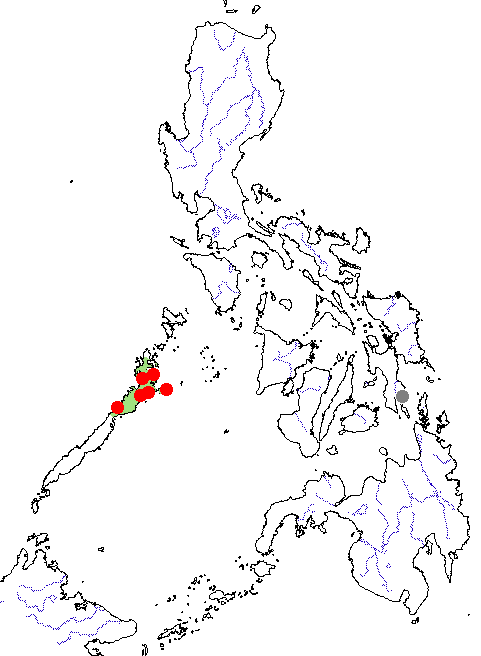Siebenrockiella leytensis, 066
Siebenrockiella leytensis (Taylor 1920) –
Palawan Forest Turtle, Philippine Forest Turtle
Arvin C. Diesmos1, James R. Buskirk2, Sabine Schoppe3,
Mae Lowe L. Diesmos4, Emerson Y. Sy5, and Rafe M. Brown6
1Herpetology Section, Zoology Division, National Museum of the Philippines,
Padre Burgos Avenue, Ermita 1000, Manila, Philippines [[email protected]];
2San Antonio Neighborhood Health Center, 1030 International Boulevard,
Oakland, California 94606 USA [[email protected]];
3Katala Foundation Inc., P.O. Box 390, Puerto Princesa City 5300,
Palawan, Philippines [[email protected]];
4Department of Biological Sciences, College of Science, University of Santo Tomas,
España 1015, Manila, Philippines [[email protected]];
5Herpetological Society of the Philippines, 1198 Benavidez Street, Unit 1202,
Tondo 1003, Manila, Philippines [[email protected]];
6Natural History Museum, Biodiversity Institute and Department of Ecology and Evolutionary Biology,
University of Kansas, Lawrence, Kansas 66045 USA [[email protected]]
Summary. – The Palawan Forest Turtle (or Philippine Forest Turtle), Siebenrockiella leytensis (Family Geoemydidae), is one of the most enigmatic species of freshwater turtles in Southeast Asia, and has been surrounded with more confusion and misconception than almost any other turtle in the region. For over 80 years, its true geographic distribution in the Philippines remained a mystery; its apparent rarity and the rudimentary knowledge of its ecology and natural history had bestowed upon it an almost mythical reputation. Long thought to come from the eastern Philippine island of Leyte, it was very recently discovered to actually occur in the Palawan region of the western Philippines. The species is the largest and heaviest geoemydid turtle known from the Philippines, attaining a carapace length of more than 300 mm and weighing as much as 3.5 kg. Known clutch size is 1–2, and eggs average 49.6 x 26.5 mm in size and weigh 18–30 g. As predicted by previous workers, the recent discovery of a natural population of S. leytensis on Palawan has already spurred a collecting frenzy among wildlife trappers and traders to supply domestic and international markets for the illegal wildlife trade. In spite of its official protected status in local and international listings, the illegal trade in S. leytensis is rampant and is perceived currently as the greatest threat to the species. This threat is exacerbated by the continuing destruction of the lowland forests of Palawan, the primary habitat of the species. If the current trend of overexploitation continues, it is certain that several subpopulations of S. leytensis will soon collapse. In the face of these threats, wildlife authorities on Palawan must immediately enforce relevant laws and encourage greater coordination among appropriate government agencies that typically work in isolation. Conservation programs need to prioritize efforts that will curb illegal collection of S. leytensis and other threatened species and monitor known populations. Top priority research studies for S. leytensis include population biology, ecology, and in-depth investigation of the dynamics of illegal trade in the species.
Distribution. – Philippines. The species appears to be restricted to the northern half of the island group of Palawan in western Philippines. It does not occur at the erroneous original type locality of Leyte Island in eastern Philippines.
Synonymy. – Heosemys leytensis Taylor 1920, Geoemyda leytensis, Siebenrockiella leytensis, Siebenrockiella (Panyaenemys) leytensis, Panyaenemys leytensis.
Subspecies. – None.
Status. – IUCN 2012 Red List: Critically Endangered (CR A2d, B1+2c) (assessed 2000); TFTSG Draft Red List: Critically Endangered; CITES: Appendix II; Philippines: Republic Act 9147 (Wildlife Resources Conservation and Protection Act).
Citation:
Diesmos, A.C., Buskirk, J.R., Schoppe, S., Diesmos, M.L.L., Sy, E.Y., and Brown, R.M. 2012. Siebenrockiella leytensis (Taylor 1920) – Palawan Forest Turtle, Philippine Forest Turtle. In: Rhodin, A.G.J., Pritchard, P.C.H., van Dijk, P.P., Saumure, R.A., Buhlmann, K.A., Iverson, J.B., and Mittermeier, R.A. (Eds.). Conservation Biology of Freshwater Turtles and Tortoises: A Compilation Project of the IUCN/SSC Tortoise and Freshwater Turtle Specialist Group. Chelonian Research Monographs No. 5, pp. 066.1–066.9, doi:10.3854/crm.5.066.leytensis.v1.2012, //iucn-tftsg.org/cbftt/.
(Adobe Acrobat 6.0 or later required)

Adult male Siebenrockiella leytensis in its primary habitat on Palawan, the lowland riparian forests from the northern region of the island. These lowland habitats are imperiled because of slash-and-burn farming, timber poaching, charcoal making, and the impacts of mining and quarrying.
Photo by Rafe Brown.
Distribution:

Distribution of Siebenrockiella leytensis in the Palawan Island group in the Philippines. Red dots = museum and literature occurrence records of native populations based on Iverson (1992), plus more recent and authors’ data; gray dot = erroneous original type locality on Leyte Island; green shading = projected native distribution based on GIS-defined hydrologic unit compartments (HUCs) constructed around verified localities and then adding HUCs that connect known point localities in the same watershed or physiographic region, and similar habitats and elevations as verified HUCs (Buhlmann et al. 2009), and adjusted based on authors’ data.








